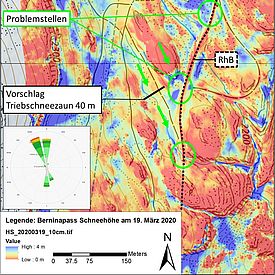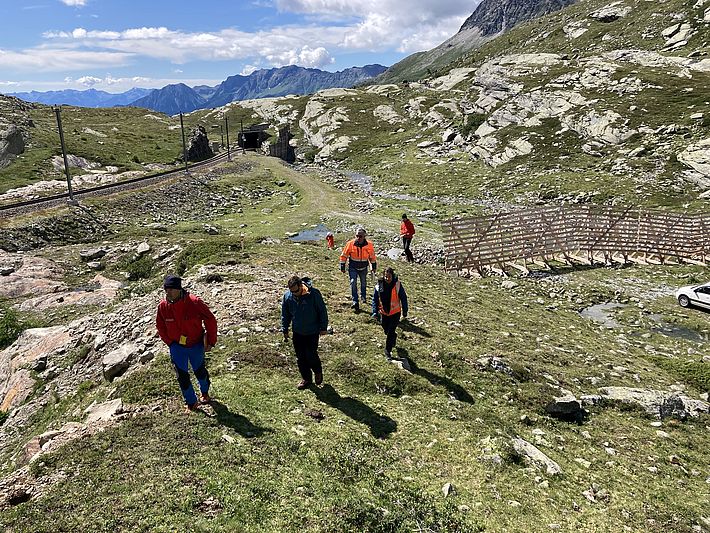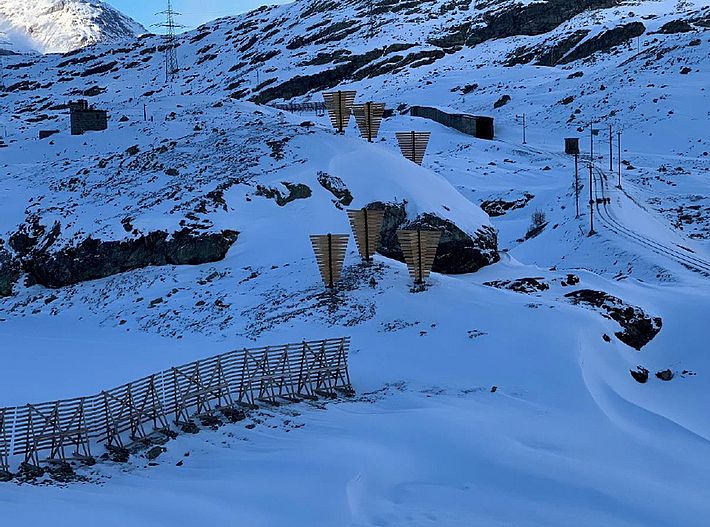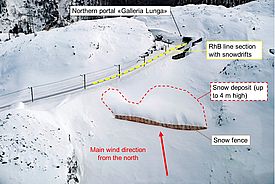20.01.2022 | Sara Niedermann | News SLF
The Bernina Express is popular with those travelling by train from Chur in Switzerland to Tirano in Italy. During winters where there is a lot of snow, services on this mountain route are repeatedly disrupted by snowdrifts. To address this issue, the Rhaetian Railway (RhB) tasked the WSL Institute for Snow and Avalanche Research (SLF) with analysing the situation and proposing protective measures. These measures are already making a difference and are now being honed further.
Located on Lago Bianco, 2,253 metres above sea level, Ospizio Bernina station is the highest point on the Bernina route. Hard winters, characterised by heavy snowfall and strong winds, are the rule rather than the exception here, and the volume and in particular the distribution of snow make it incredibly difficult for the RhB to keep the exposed railway connection open every day. The wind blows a lot of snow onto the tracks running along Lago Bianco in particular. Although heavy machinery such as track ploughs and snow blowers are used to clear snow from the rail network, the snow often has to be removed manually as well, which requires a huge amount of time and effort.

Initial measures successfully implemented
With a view to improving the situation, the RhB commissioned the SLF to analyse the problem areas and snow distribution and suggest potential protective measures. To this end, SLF researchers took drone photos and used these to create snow depth maps. The SLF then worked with the RhB and the Forestry and Natural Hazards Office of the Canton of Grisons to estimate the impact of possible measures.
One of the problem areas is the northern entrance (known as a portal) to the Galleria Lunga tunnel, which is often blocked by snowdrifts. To rectify the situation, the decision was made to erect a 40-metre-long, four-metre-high wooden snow fence; this fence was installed in autumn 2020. Such fences slow down the wind, ensuring that snow is deposited specifically on the leeward side and consequently reducing the amount of snow blown onto the tracks.
Results and next steps
The snow fence proved effective last winter, with several thousand cubic metres of snow reaching heights of up to four metres being deposited on the leeward side of the fence. "Without the fence, this snow would have been deposited around the rails and the portal," says Stefan Margreth, Head of the SLF's Avalanche Protection Measures research group.
The researchers hope to further optimise the measures by installing six cruciform wind baffles. These were built in autumn 2021 and affect snow in a different way to snow fences. Rather than holding back the snow, they optimise snow distribution by influencing the area's wind field and preventing the formation of large snowdrift accumulations and cornices that extend to the rails.
Over the next few winters, the SLF will conduct inspections and create snow depth maps to verify the impact of the measures taken and will suggest improvements if necessary.


Contact ¶
Copyright ¶
WSL and SLF provide the artwork for imaging of press articles relating to this media release for free. Transferring and saving the images in image databases and saving of images by third parties is not allowed.

